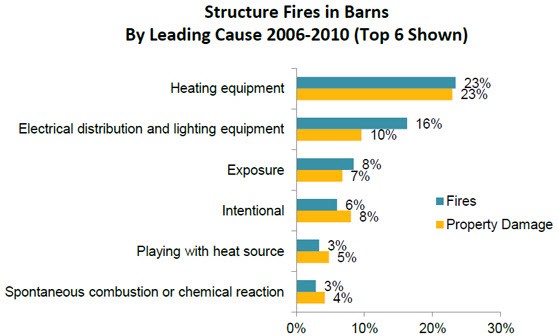Per the National Fire Prevention Association (NFPA), from 2006 to 2010, there were 830 structure fires in livestock or poultry barns, stockyards and animal pens. These fires cause millions of dollars in property damage, loss of animals, and injuries and deaths to farmers and farm workers.
Egress Requirements
Building codes require livestock and poultry barns to be equipped with at least two exits. These exits need to be configured so that a fire does not block all exits. Egress distance from any point in the building cannot exceed 75 feet for non sprinklered buildings and 100 feet for sprinklered buildings. The exits need to be kept clear and at least 32 inches wide or 1.5 times the width of the largest animal or piece of equipment needed for egress. Please see NFPA 150 for more details: http://www.nfpa.org/codes-and-standards/all-codes-and-standards/list-of-codes-and-standards?mode=code&code=150
Fire Causes
 Livestock and poultry barns present some unique conditions that increase the risk for fire. Electrical and heating components are subjected to high humidity and exposure to corrosive urine and manure. This equipment needs to be sealed from the moisture/corrosion and periodically inspected to make sure the connections are kept clean, dry and tight.
Livestock and poultry barns present some unique conditions that increase the risk for fire. Electrical and heating components are subjected to high humidity and exposure to corrosive urine and manure. This equipment needs to be sealed from the moisture/corrosion and periodically inspected to make sure the connections are kept clean, dry and tight.
Keep the area around your electric panels and heaters free of combustible material. NFPA code requires 36 inches of clearance. This clearance is needed to allow for sparks or flames from a malfunction without starting the rest of the building on fire.
Also, watch out for combustibles and bedding around heat lamps or incubators. Make sure adequate clearance is maintained and that any heat producing equipment has proper clearance and is properly secured.
Fire Detection/Early Suppression
Consider fire detection and suppression systems. This equipment has gotten better and cheaper with advancements in electronics and heat resistant plastics. Also, make sure you provide an adequate number of fire extinguishers. NFPA requires the travel distance to a fire extinguisher from any point in a livestock or poultry barn to be no more than 50 feet. Fire extinguishers need to be serviced annually and inspected monthly. Also, make sure anyone working at your operation knows how to use them.
As you winterize your buildings and start your heaters and furnaces, take a few minutes to inspect your buildings and make sure that adequate egress and housekeeping around your electrical panels and heaters is a priority. As you work inside your buildings, make sure that you have two clear and quick exit routes. It could save the lives of you and your coworkers.


